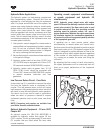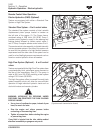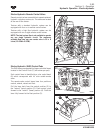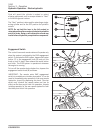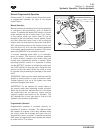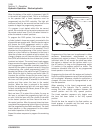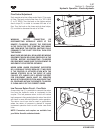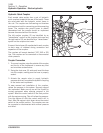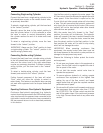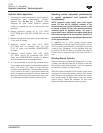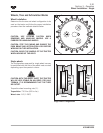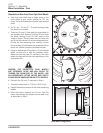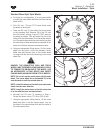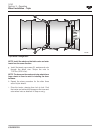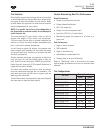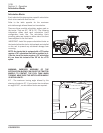
435/485/535
3-89
Connecting Single-acting Cylinders
Connect the hose from a single-acting cylinder to the
left extend/raise coupler on the remote control valve,
as previously described.
To extend a single-acting cylinder, pull the lever back
to the “extend” position.
Manually return the lever to the neutral position to
stop the cylinder before it is fully extended or allow
the valve to return to neutral automatically when
the cylinder reaches the end of its stroke and timed
operation.
To retract a single-acting cylinder, move the lever
forward to the “retract” position.
IMPORTANT: Always use the “float” position to lower
a single-acting cylinder. The “retract” position is for
double-acting cylinders only.
Connecting Double-acting Cylinders
Connect the feed hose from a double-acting cylinder
to the left extend/raise coupler on the remote control
valve and the return hose to the right retract/lower
coupler, as previously described. To extend a double-
acting cylinder, pull the lever back to the “extend”
position.
To retract a double-acting cylinder, push the lever
forward past neutral to the “retract” position.
Further forward movement of the lever will select
“float” which will allow the cylinder to extend or
retract freely. This feature is very helpful when carrying
out work with equipment such as scraper blades and
loaders.
Operating Continuous Flow Hydraulic Equipment
Continuous flow hydraulic equipment (e.g. hydraulic
motors) should be connected to the 3RD remote control
valve couplers with the pressure hose connected to the
right retract coupler and the return hose connected to
the low pressure return circuit as described previously
in this section.
Use the flow control to regulate the motor speed. The
#1 flow control should be adjusted to regulate the orbit
motor speed. If the flow control is open too far, the
3-point hitch and other remote valves will slow down
or stop. This will ensure that the hydraulic system will
only supply the oil required by the motor. Extra pump
capacity will not be used except when other remote
valve sections are operated.
With the remote lever fully forward in the “float”
position, the motor will be stationary. The hydraulic
motor will operate if the lever is pushed forward to the
“retract” position. To stop the motor, move the lever
from the retract position to the float position. In the
float position the motor will be able to stop slowly,
which will not damage the motor.
IMPORTANT: When operating continuous flow
equipment, the remote control valve lever must not
be moved rearward to the neutral or raise positions as
damage to the equipment may result.
Observe the following to further protect the tractor
and equipment.
• Do not open any bypass valve in the equipment or
motor. Use the flow control to regulate the rate of
flow or speed of the motor.
• Do not hold the remote control valve lever to
operate the equipment.
• To ensure optimum hydraulic oil cooling, operate
continuous flow equipment at the highest flow
setting (by use of the flow control) and lowest
engine speed that will give the required machine
performance and speed.
• Do not use the #1 valve circuit to operate continuous
flow equipment that requires more than 137.90
bar (2,000 PSI). The #1 flow control may shut the
rest of the system down if the continuous pressure
is too high. Connect these loads to any other valve
section.
Section 3 - Operation
Hydraulic Operation - Electro-hydraulic



